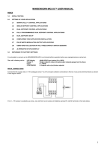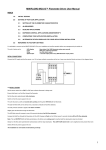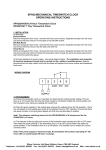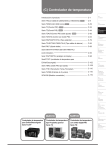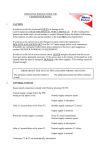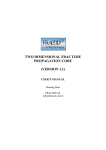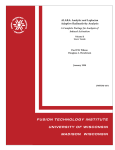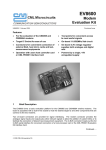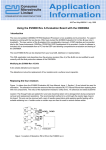Download 1 MINITACH2-MCU-D™ Tachometer Relay User Manual
Transcript
MINITACH2-MCU-D™ Tachometer Relay User Manual INDEX 1.0 INITIAL TESTING 2.0 SETTING UP FOR YOUR APPLICATION 3.0 2.1 ALARM MODES 2.2 COMPLETING YOUR APPLICATION INSTALLATION 2.3 PULSE WIDTH MODULATION OUTPUT APPLICATIONS 2.4 ALTERNATIVE STATUS DISPLAY FOR YOUR APPLICATION INSTALLATION RETURNING TO FACTORY SETTINGS It is advisable to connect up the MINITACH2-MCU-D to your installation and confirm operation before any reprogramming is carried out. The unit is factory set to: LED display Input Range T1 Alarm mode Alarm output Inrange output RPM status (0 to 100% of selected range) NPN open collector RPM sensor 1,000 - 10,000 RPM. Low RPM Relay Optocoupler INITIAL CONNECTIONS Connect the DC supply and the RPM sensor +ve, 0V and open collector connections to the two 4 way screw terminal block as shown in the diagram below: 1.0 INITIAL TESTING If a PNP open collector RPM sensor is used, move the sensor select link to from NPN to PNP. Ensure that the RPM sensor is not activated. Set the RPM alarm potentiometer fully clockwise. Switch on the DC power supply to the unit. The module will power up with a 2 second start up delay and the green STATUS LED will illuminate. The LED will then blink (on for 25ms) every 2 seconds to indicate RPM UNDERRANGE condition. The relay will also activate to signal a low alarm condition. Activate the RPM sensor increasing the speed to over 1000 RPM. The LED blinking rate will increase to every 0.8 seconds indicating 10 to 20% max RPM detected. Note that the red OUTPUT 2 LED will illuminate indicating RPM is now INRANGE. Increase the speed further until the green LED changes to flash (on for 400ms) every 2 seconds indicating 20 to 40% max RPM detected. Slowly turn flow alarm potentiometer anticlockwise until the relay deactivates. The RPM alarm level is set to slightly less than present RPM input. Switch off the DC power supply to the unit. The Installation is now tested and functioning correctly. 1 2.0 SETTING UP YOUR APPLICATION The MINITACH2-MCU-D provides comprehensive RPM alarm features over a wide range of RPM and can be easily configured for your particular application. An integral LED system status indicator is provided for diagnostic purposes and can be set up to indicate RPM or alarm status. Simply follow the step by step process below to set up your application: 2.1 ALARM ONLY APPLICATIONS In these applications the unit is set up to provide an alarm output whenever the actual RPM is: less than (LOW ALARM) or greater than (HIGH ALARM) or within a band (INBAND) of or outside a band (OUTBAND) of or the set ALARM setpoint. FIRSTLY REMOVE ALL FOUR SET UP JUMPER LINKS, then choose the alarm mode most suitable for your application: LOW ALARM In this mode the alarm output is active (on) when the actual RPM is less than the 0 – 100 potentiometer setpoint%. Already factory set. HIGH ALARM In this mode the alarm output is active (on) when the actual RPM is greater than the 0 – 100 potentiometer setpoint%. Set up as follows: Insert the programming plug - facing right - offset, upper (STARTMODE) - onto the vertical left hand 6 pin SET UP header. Switch on the power to the unit The STATUS LED will illuminate continuously to indicate High Alarm set. Switch off the power and remove the programming plug. Repeat the procedure to return to Low Alarm. The STATUS LED will blink on continuously to indicate Low Alarm reset. Switch off the power and remove the programming plug. INBAND ALARM In this mode the alarm output is active (on) when the actual RPM is within a preset % band directly below the potentiometer setpoint%. Choose your preset % band from the table below: BANDSETNUMBER 0 PERCENTAGE RPM BAND Unit set to high/low alarm operation 1 10 2 20 3 30 4 40 5 50 and set up as follows: Insert the programming plug - facing right - centralised (MYTIME) - onto the vertical left hand 6 pin SET UP header. Rotate the alarm potentiometer fully anticlockwise. Switch on the power to the unit. The LED will blink slowly to indicate ready to program. Rotate potentiometer full clockwise to start counting in BandSetNumber ( eg 3 for 30%). The LED will flash quite slowly for each count. Remember digital counting starts at zero not one. Count the flashes 0,1,2 then on 3 (in the example) rotate potentiometer fully anticlockwise to store 3. 2 Switch off the power and remove the programming plug. OUTBAND ALARM In this mode the alarm output is active (on) when the actual RPM lies outside a preset % band directly below the potentiometer setpoint%. Set up your preset % band as per the INBAND procedure above then: Insert the programming plug - facing right - offset, upper (STARTMODE) - onto the vertical left hand 6 pin SET UP header. Switch on the power to the unit. The LED will illuminate continuously to indicate Outband Alarm set. Switch off the power and remove the programming plug. Repeat procedure to return to Inband Alarm. The LED will blink on continuously to indicate Inband Alarm reset. Switch off the power and remove the programming plug. RPM RANGE The RPM input range of the module spans 10 to 15,000 RPM in four dual ranges. Identify, from the table below, the range where your maximum and minimum RPM limits are towards the top end. Normal T1 1,000 – 10,000 RPM factory set T2 500 – 5,000 RPM T2 T3 100 – 1,000 RPM T3 T4 50 – 500 RPM T2 & T3 Hi/Low Alternative T1 HI 1,500 – 15,000 RPM factory set T2 HI 750 – 7,500 RPM T2 T3 HI 250 – 2,500 RPM T3 T4 LO 10 – 100 RPM T2 & T3 Only if the range identified is one of the Hi/Low alternatives: Insert a red jumper link - vertically - centralised - onto the vertical left hand 6 pin SET UP header. Switch on the power to the unit. The LED will illuminate continuously to indicate HI/LO ranges programmed. Switch off the power and remove the programming plug. Repeat the procedure, if required, to reset normal range. The LED will blink on continuously to indicate normal T1 to T4 range reset. Switch off the power and remove red jumper link. 3 2.2 COMPLETING YOUR APPLICATION INSTALLATION The unit is now ready for final set up and installation testing: 1 Check your final alarm band, display status and pulse width modulation output set up. Insert the programming plug - facing right - centralised (MYTIME) - onto the vertical left hand 6 pin SET UP header. Rotate the setpoint potentiometer fully clockwise. Switch on the power to the unit and wait for the LED to illuminate continuously. Rotate the setpoint potentiometer fully anticlockwise. After one second the unit will automatically count out the BandSetNumber on the LED. Remember digital counting starts at zero not one. (e.g. 3 stored). Band Set digit Count the flashes 0, 1, 2 & 3, done. Wait three seconds. Display set digit Count the flashes 0 or 1 (0 RPM display set, 1 Alarm display set). Wait three seconds. PWM set digit Count the flashes 0 or 1 (0 Inrange output active, 1 PWM output active). The LED will illuminate continuously to indicate countout complete. Switch off the power to the unit. Remove the programming plug (MYTIME) from the 2 pin PROG header. 2 Set up Range: T1/T1HI - T2 jumper link in left, T3 jumper link in left. T2/T2HI - T2 jumper link out right, T3 jumper link in left. T3/T3HI - T2 jumper link in left, T3 jumper link out right. T4/T4LO - T2 jumper link out right, T3 jumper link out right. 3 Select sensor type: NPN jumper link for NPN open collector sensor. or PNP jumper link for PNP open collector sensor. 4 Select alarm output: OUTPUT jumper link in left (Relay alarm /Optocoupler inrange) or OUTPUT jumper link out right (Optocoupler alarm /Relay inrange) 5 DIN rail mount unit. 6 Install the RPM sensor and the power, relay and optocoupler connections. 7 Set the setpoint% potentiometer to your application ALARM level (e.g. 75%) (Note if a 30% RPM band has been programmed the alarm band will be from 75 – 30 = 45 to 75%). 8 Switch on the unit and wait 5 seconds. 9 Check that the STATUS LED is blinking slowly (UNDERRANGE). 10 Check that the appropriate Alarm output state is correct according to your set up: - on, LOW ALARM - off, HIGH ALARM - off, INBAND ALARM - on, OUTBAND ALARM. 11 Switch on the normal RPM for the application (e.g. 50%). 4 12 Recheck that the Status LED state is correct for the application: 0 to 20% RPM LED blinks on every 0.8 seconds 20 to 40% RPM LED flashes on every 2 seconds e.g. 40 to 60% RPM LED flashes on every 0.8 seconds 60 to 80% RPM LED blinks off every 0.8 seconds 80 to 100% RPM LED on continuously. 13 Check that the Alarm output state in this normal RPM condition is correct according to your set up. 14 Check that the appropriate INRANGE output is functioning correctly. 15 Adjust the RPM (over the range of RPM in your application), using the Status LED indication, to check each ALARM state. 16 Finely adjust the setpoint% setting, if necessary, to achieve your application ALARM level. 17 And finally if you wish to protect your set up against unauthorised adjustment: Switch off the power to the unit. Temporarily remove all SET UP jumper links. Insert the programming plug - facing right - offset, lower (LOCKPOT) - onto the vertical left hand 6 pin SET UP header Switch on the power to the unit. The LED will illuminate continuously to indicate setpoint% setting is now locked. Switch off the power and remove the programming plug. Repeat the procedure, if required, to unlock the potentiometer. The LED will flash every two seconds to indicate potentiometer is now unlocked. Switch off the power and remove the programming plug. Replace all jumper links into their previous positions. 18 Record your final set up details on configuration label on the side of the unit: Installation is now complete. 5 2.3 PULSE WIDTH MODULATION OUTPUT APPLICATIONS The MINITACH2-MCU-D has an inbuilt pulse width modulation (pwm) feature. This provides a nominal 50Hz pulse width modulated output signal representing 0 – 100% RPM. This output can only be assigned to the optocoupler. The PWM signal can easily be converted to a 0 – 10V/ 0 – 1mA analogue output. Note: Output load 0 – 10V > = 1Mohm, 0 – 1mA < = 100 ohm. The potentiometer can be used to calibrate the analogue output to an external reference standard at the normal operating RPM. Remove all SET UP jumper links. Insert the programming plug - facing right - centralised (MYTIME) - onto the vertical left hand 6 pin SET UP header. Rotate the RPM alarm potentiometer fully anticlockwise. Switch on the power to the unit. The LED will blink slowly to indicate ready to program. Skip setting 1 Rotate potentiometer fully clockwise, then on the first flash rotate potentiometer fully anticlockwise to activate factory setting 1. This will be reprogrammed later, if required. The LED will now fast blink to indicate ready to program. Skip setting 2 Rotate potentiometer fully clockwise, then on the first flash rotate potentiometer fully anticlockwise to activate factory setting 2. This will be reprogrammed later, if required. The LED will now fast blink off to indicate ready to program. Rotate potentiometer fully clockwise to start counting. The LED will flash quite slowly for each count. Remember digital counting starts at zero not one. PWM set digit Count the flashes, 0 then on 1 rotate potentiometer fully anticlockwise. PWM OPTO OUTPUT SET. The LED will illuminate continuously to indicate programming complete. Switch off the power and remove the programming plug. Note: To return to opto as INRANGE output, repeat procedure and Count the flashes, on 0 rotate potentiometer fully anticlockwise. INRANGE OPTO OUTPUT RESET. Now return to section 2.1/Alarm Modes to re-complete your installation. 6 2.4 ALTERNATIVE STATUS DISPLAY FOR YOUR APPLICATION INSTALLATION After you have completed and tested your application (including PWM feature, if required) you may wish to change the diagnostic status display indication. The factory set status display provides an indication of the current RPM%. The status display can be changed to indicate the current alarm state: No RPM UNDERRANGE LED blinks on every 2 seconds RPM < lower band RPM/alarm potentiometer LED blinks on every 0.8 seconds RPM within lower/higher band RPM/alarm pot LED on continuously RPM > higher band RPM LED flashes on every 0.8 seconds > 100% OVERRANGE LED flashes on every 3 seconds Set up this display mode using the PROGPLUG programming key as shown below: Remove all SET UP jumper links. Insert the programming plug - facing right - centralised (MYTIME) - onto the vertical left hand 6 pin SET UP header. Rotate the RPM alarm potentiometer fully anticlockwise. Switch on the power to the unit. The LED will blink slowly to indicate ready to program. Skip setting 1 Rotate potentiometer fully clockwise, then on the first flash rotate potentiometer fully anticlockwise to activate factory setting 1. Must now be reprogrammed. The LED will fast blink to indicate ready to program. Rotate potentiometer fully clockwise to start counting. The LED will flash quite slowly for each count. Remember digital counting starts at zero not one. Display set digit Count the flashes, 0 then on 1 rotate potentiometer fully anticlockwise: ALARM DISPLAY PROGRAMMED. The LED will illuminate continuously to indicate programming complete. Switch off the power and remove the programming plug. Note: To return to RPM DISPLAY, repeat procedure and Count the flashes, on 0 rotate potentiometer fully anticlockwise: RPM DISPLAY RE-PROGRAMMED. If you change the display status, return to section 2.1/Alarm Modes and re-program the inband/outband %band set up. 7 3.0 RETURNING TO FACTORY SETTINGS When you start using the programmable features in the unit you can if necessary return to the factory settings and start again. Simply: Remove all SET UP jumper links. Rotate the setpoint% potentiometer fully clockwise. Insert a red jumper link - vertically - centralised - onto the vertical left hand 6 pin SET UP header Switch on the power to the unit. The LED will either illuminate continuously to indicate HI/LO ranges programmed or The LED will blink on continuously to indicate normal T1 to T4 range reset. Rotate the setpoint% potentiometer fully anticlockwise to switch off the LED. Rotate the setpoint% potentiometer fully clockwise. The LED will flash on/off continuously to indicate RESET ACTIVATED. Rotate the setpoint% potentiometer fully anticlockwise. The LED will illuminate continuously to indicate FACTORY SETTINGS restored. Switch off the power and remove the programming plug. Restore all four jumper links to their factory set positions. Tempatron: Eltime House, Hall Road, Maldon, Essex, CM9 4NF UK. Tempatron Industrial Controls is a division of Eltime Ltd. © Eltime Ltd. Tempatron MINITACH2-MCU-D User Manual 01/2014 8








